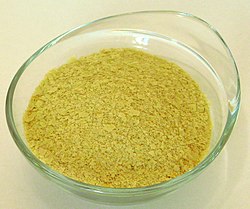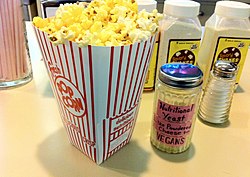

| Nutritional value per 15 g | |||||||||||||||||||||||||||||||
|---|---|---|---|---|---|---|---|---|---|---|---|---|---|---|---|---|---|---|---|---|---|---|---|---|---|---|---|---|---|---|---|
| Energy | 250 kJ (60 kcal) | ||||||||||||||||||||||||||||||
5 g | |||||||||||||||||||||||||||||||
| Sugars | 0 g | ||||||||||||||||||||||||||||||
| Dietary fibre | 3 g | ||||||||||||||||||||||||||||||
0.5 g | |||||||||||||||||||||||||||||||
8 g | |||||||||||||||||||||||||||||||
| |||||||||||||||||||||||||||||||
| Other constituents | Quantity | ||||||||||||||||||||||||||||||
| Cholesterol | 0 mg | ||||||||||||||||||||||||||||||
Bob's Red Mill brand, manufacturer reported values.[1]
See also SR LEGACY data for yeast (active dry #1103594) for an idea about pre-fortification values and nutrients not reported above. SR surveys are performed by unbiased USDA personnel. | |||||||||||||||||||||||||||||||
| †Percentages estimated using US recommendations for adults,[2] except for potassium, which is estimated based on expert recommendation from the National Academies.[3] | |||||||||||||||||||||||||||||||
Nutritional yeast (also known as nooch[4]) is a deactivated (i.e. dead) yeast, often a strain of Saccharomyces cerevisiae, that is sold commercially as a food product. It is sold in the form of yellow flakes, granules, or powder and can be found in the bulk aisle of most natural food stores. It is popular with vegans and vegetarians and may be used as an ingredient in recipes or as a condiment.[5]
It is a significant source of some B-complex vitamins and contains trace amounts of several other vitamins and minerals.[6] Sometimes nutritional yeast is fortified with vitamin B12, another reason it is popular with vegans.
Nutritional yeast has a strong flavor that is described as nutty or cheesy, which makes it popular as an ingredient in cheese substitutes. It is often used by vegans in place of cheese[7] in, for example, mashed and fried potatoes or scrambled tofu, or as a topping for popcorn.[8]
Though "nutritional yeast" usually refers to commercial products, inadequately fed prisoners of war have used "home-grown" yeast to prevent vitamin deficiency.[9] Nutritional yeast is a whole-cell inactive yeast that contains both soluble and insoluble parts, which is different from yeast extract. Yeast extract is made by centrifuging inactive nutritional yeast and concentrating the water-soluble yeast cell proteins which are rich in glutamic acid, nucleotides, and peptides, the flavor compounds responsible for umami taste.
- ^ "FoodData Central #1946780". fdc.nal.usda.gov.
- ^ United States Food and Drug Administration (2024). "Daily Value on the Nutrition and Supplement Facts Labels". FDA. Archived from the original on 27 March 2024. Retrieved 28 March 2024.
- ^ National Academies of Sciences, Engineering, and Medicine; Health and Medicine Division; Food and Nutrition Board; Committee to Review the Dietary Reference Intakes for Sodium and Potassium (2019). Oria, Maria; Harrison, Meghan; Stallings, Virginia A. (eds.). Dietary Reference Intakes for Sodium and Potassium. The National Academies Collection: Reports funded by National Institutes of Health. Washington, DC: National Academies Press (US). ISBN 978-0-309-48834-1. PMID 30844154. Archived from the original on 9 May 2024. Retrieved 21 June 2024.
- ^ Hughes, Becky (8 May 2020). "Nutritional Yeast Is for Hippies. 'Nooch' Is for Everyone". The New York Times. Retrieved 3 October 2022.
- ^ Brown, Elizabeth (25 April 2009). "Singing the praises of nutritional yeast". Santa Monica Daily Press. Retrieved 7 October 2012.
- ^ "Large flake nutritional yeast". USDA Branded Food Products Database. United States Department of Agriculture. Retrieved 26 September 2018.[dead link]
- ^ Stepaniak, Joanne (2003). The Ultimate Uncheese Cookbook (10th ed.). Summertown, Tenn.: Book Pub. Co. p. 32. ISBN 978-1-57067-151-7.
- ^ Wasserman, Debra (1997). Conveniently Vegan (Revised. ed.). Baltimore, Md.: Vegetarian Resource Group. p. 29. ISBN 978-0-931411-18-2.
- ^ J G Lee HARUKOE (HARUKU)